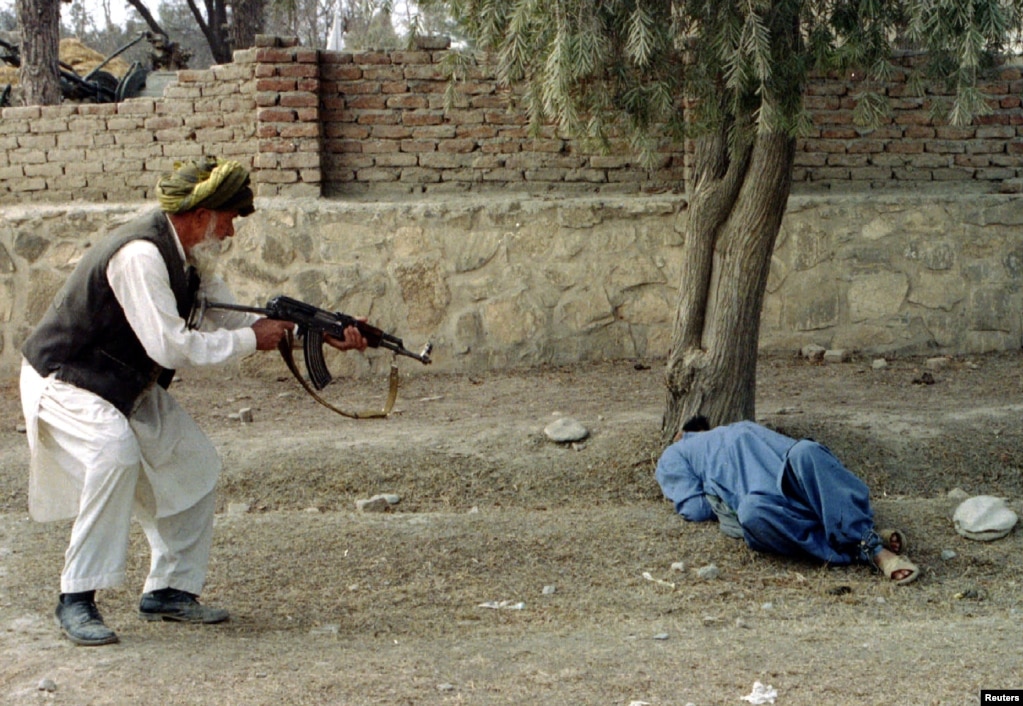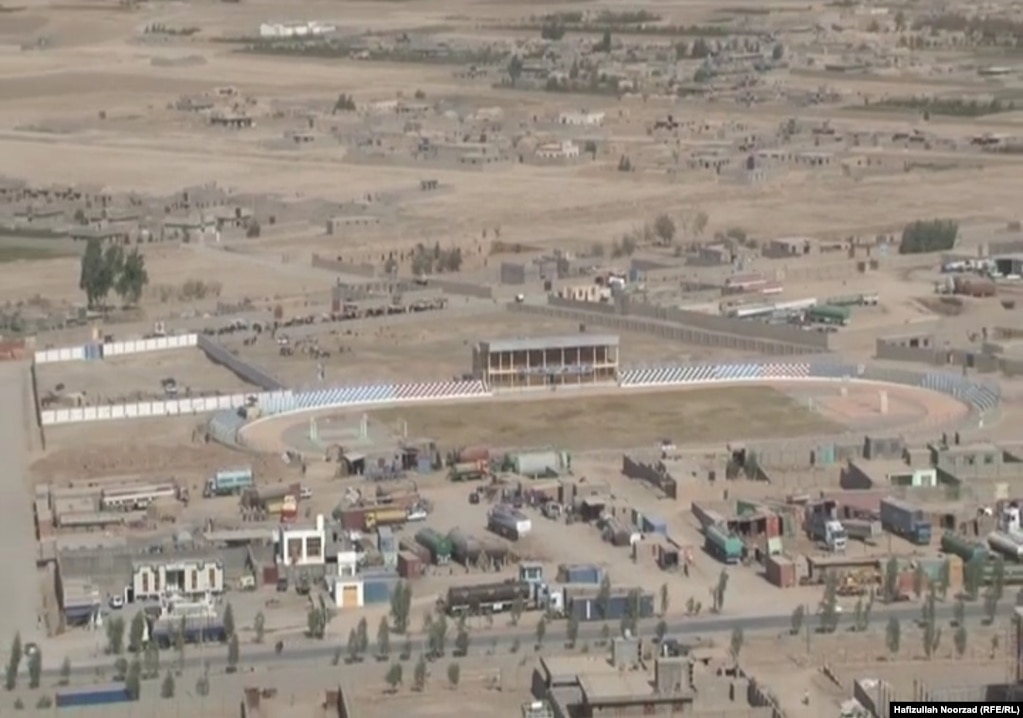
With the recent execution of three convicted murderers in separate incidents, the Taliban has sent a very public message that its infamous “eye for an eye” approach to justice has been restored in Afghanistan.
“Qisas,” or retributive Islamic punishments that can include killings at the hands of victims’ families, were a trademark of the Taliban’s first stint in power in Afghanistan from 1996 to 2001.
After a nearly 20-year reprieve under new governance, the hard-line Islamist group has vowed since its takeover in 2021 to revive the practice in its push to reimpose its strict interpretation of Islamic law.
The public shootings of the three men in the past two weeks show the Taliban was issuing promises, not threats.
In a throwback to the executions carried out in stadiums under the previous Taliban regime, all three were executed by heirs of their victims in front of spectators.
On February 22, Syed Jamaluddin and Gul Khan were shot dead inside a soccer stadium in the southeastern province of Ghazni. “One was shot eight times while the other received six bullets,” an eyewitness who requested anonymity told RFE/RL’s Radio Azadi.
Days later, on February 26, an unidentified man shot Nazar Mohammad inside a sports stadium in the northern province of Jawzjan. The shooter was avenging the death of his brother, Khal Mohammad, two years ago.
Such “eye for an eye” forms of justice, which include qisas as well as corporal “hudood” punishments such as amputations for lesser crimes, are carried out for crimes and offenses considered to violate God’s boundaries.
The recent executions are not the first since the Taliban returned to power.
In December 2022, just a month after Taliban leader Mullah Haibatullah Akhundzada ordered the return of Islamic punishments, a convicted murderer was shot dead by his victim’s father in front of hundreds of onlookers in the western Farah Province.
Last June, a man convicted of killing five people was executed in the eastern Laghman Province, according to the Taliban, which did not say how the sentence was carried out.
Since Akhundzada’s order, the Taliban has also flogged, stoned, or amputated the body parts of hundreds of people for crimes such as theft and adultery.
The executions and punishments have been condemned by Afghans and abroad, and experts have questioned their validity under Islamic law and say they are mainly intended to incite fear.
Islamic Shari’a law can only be implemented as part of an overarching governing framework under a legitimate government accountable to the people, according to Afghan Islamic scholars.
“Judges who rule on such punishments must be famous for their fairness and in-depth knowledge,” said professor Fazluminullah Mumtaz, an expert in Islamic jurisprudence. He added that judges “are obliged to have a thorough understanding of the jurisprudential and Shari’a aspects of the sentence and its execution.”
That is not the case under the Taliban, which has gutted the Afghan judiciary and whose government is not recognized by any country.
The hard-line Islamist group has scrapped or suspended all laws implemented by the previous government, which constitutionally allowed for Islamic law while also adhering to international legal and rights norms.
And since taking over in 2021, the Taliban has fired thousands of judges, public prosecutors, and lawyers and replaced them with loyalists, most of whom are clerics.
“The Taliban government does not even have relative legitimacy and it operates in a legal vacuum,” Subhanullah Misbah, an Afghan legal expert, told Radio Azadi.
The Taliban has effectively recreated its “Islamic emirate” of the 1990s, under which such punishments became a hallmark of its brutal take on Islamic law.
The group’s insistence on pursuing its vision of Shari’a is widely seen as one of the reasons the Taliban has strongly resisted demands by Afghans and the international community that it allow the establishment of an inclusive government.
Its refusal to bend, despite initial promises to adhere to international law, has given the Taliban a monopoly on power but has also increased its isolation globally and fomented domestic political and economic crises.
All this, Misbah says, means the Taliban has failed to gain the qualifications required to determine the course of Islamic law. “No one in Afghanistan will oppose the implementation of Shari’a, but the Taliban first must meet the prerequisites for implementing such laws,” he said. “Implementing capital punishments now will only spread fear in society.”
Under the previous government, capital punishment was allowed in compliance with international law, and death sentences — mostly by hanging — were carried out in prisons.
But the return of public executions have alarmed the United Nations and global rights watchdogs. “Public executions are a form of cruel, inhuman, or degrading treatment, or punishment,” said Jeremy Laurence, a spokesman for the UN Office for the High Commissioner on Human Rights.
In a February 28 statement, he pointed out that such execution was arbitrary and “contrary to the right to life protected under the International Covenant on Civil and Political Rights, to which Afghanistan is a state party.”
Amnesty International has called an immediate halt to such executions. “Carrying out executions in public adds to the inherent cruelty of the death penalty,” said Livia Saccardi, Amnesty International’s deputy director for South Asia. “And can only have a dehumanizing effect on the victim and a brutalizing effect on those who witness the executions.”
Some rights campaigners oppose the death penalty globally and frequently oppose its implementation, including in Muslim countries where it is rooted in or inspired by Shari’a. Sunni Saudi Arabia and Shi’ite Iran are among the world’s leading executioners. All executions, including qisas, in these countries are justified according to their interpretation of Islamic law.
Graeme Smith, a senior Afghanistan analyst at the International Crisis Group, says that the Taliban’s approach to justice did gain some legitimacy among Afghans, particularly in rural areas in the south and east of the country, when the group was fighting against the pro-Western government from 2002 to 2021.
Smith says this was because some Afghans — frustrated by the rampant corruption in the Kabul-run court system — preferred to take their cases before the insurgents. “Human rights organizations will rightly condemn these executions,” he said. “However, it’s worth remembering the recent history in Afghanistan, where many executions happened secretly.”
After a communist coup in April 1978 toppled a republican government, Afghanistan witnessed large numbers of extrajudicial killings under communist, Islamist, and pro-Western governments.
“Many aspects of that violent legacy are still to be uncovered as journalists and other investigators gain access to former battlefields,” Smith said.
Source : Radio Free Europe


